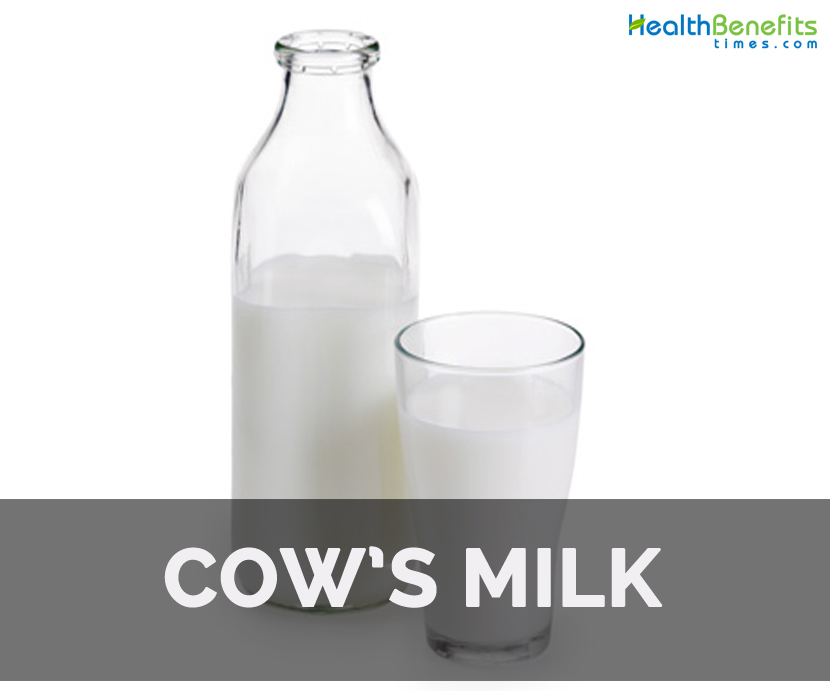History
In 10000 BC along with agricultural revolution, the domestication of animals also started for milk. The dairy products and milk was restrained for wealthy, priests and royalty. In Europe, the sheep and cows were value highly for milk in 5th century. The milk of cow was well known in comparison to the sheep’s milk in 14th century. In early 1600s, European dairy cows accompanied to North America. The pasteurization test was made by a French microbiologist named Louis Pasteur in 1862. In 1895, the machines for commercial pasteurization were introduced. The first milk bottle was introduced in 1884 in New York. Milk cans was replaced by tanks in 1930s. The invention of plastic coated paper milk cartons assist in the wider distribution of milk.
Health Benefits of Cow’s milk
Cow’s milk is a great source of calcium, potassium and Vitamin D. It is used to make other forms of dairy such as yogurt, cheese and others. Cow’s milk is able to lower fat, enhance immunity, prevent diabetes, protect heart health, strong teeth and bones, lower inflammation, stimulates growth and assist weight loss.
- Bone health
Milk is essential for the maintenance of strong bones. It is rich in calcium as well as other minerals for the density of bones. Moreover, it has adequate amount of proteins which is helpful for the teeth along with bones. Milk is effective for strengthening the mineral density of bones. (1)
- Healthy heart
Cow’s milk has high concentration of Omega-3 fats which are healthy forms of cholesterol level in the body. It also promotes heart health and prevents the chances of cardiovascular ailments such as strokes and heart attacks. (2)
- Treat diabetes
The study shows that consumption of milk helps to regulate the level of blood sugar in the body. Due to the high content of minerals and Vitamin B, it assist metabolism and regulates the insulin and glucose levels. It prevents diabetes by normalizing the level of blood sugar. (3)
- Supports weight loss
The research shows that milk supports weight loss, satiety and cause fullness. It has high content of protein and low content of calories. It enhance metabolism and provides energy. The high level of metabolism assists weight loss. (4)
- Prevent inflammation
Milk is an aid for arthritis, gout, skin burns and respiratory ailments. It possesses omega-3 fatty acids, protein, antioxidants and anti-inflammatory properties. The nutrients found in milk cures stomach inflammation, promotes nutrient absorption and digestion efficiency. (5)
- Assist development
Protein is vital for the functions of body. It has complete proteins which are used for the energy production, development and growth. The regular intake of milk assists development and growth. (6)
- Enhance immunity
Milk has high content of protein and calcium. It also contains antioxidant compounds such as selenium, Vitamin E and zinc that could eliminate harmful free radicals that could cause chronic illness and mutations. The research also shows that it could lower the chances of heart disease and cancer. It promotes the skin’s appearance and its youthfulness. (7)
Precautions
- People with lactose intolerance should not consume it.
- The people with Parkinson’s disease and cow milk allergy should avoid it.
- Raw milk results in stomach cramping, diarrhea and vomiting.
- High consumption of raw milk cause hiccups, shwasa and respiratory ailments.
How to Eat
- Mix banana and other fruits with milk to make a shake.
- Raisins, milk, nutmeg and cinnamon could be added in a rice pudding.
- Make a hot chocolate by mixing unsweetened dark chocolate, milk and honey.
- Put some milk to a hot cereal.
- It could be used to make cream, ice cream, buttermilk, butter, paneer and khoya.
- Milk is a necessity for coffee, tea and milkshakes.
- It is also used to make halwa, sheera etc.
- It is also added in chocolate based desserts.
- It is used to make pastas and white sauce.
Other Facts
- It has become a dietary food for adults and children.
- It is associated with various health ailments.
- About 90 percent of the milk is fulfilled by cow’s milk.
- Finland is the highest milk consumption country.
- California is the highest producer of milk.
Cow’s milk facts
The nutritious fluid which is made in dairy cows udders to preserve the newborn calf all along the first months of life. Cow’s milk is used to make the food products such as cream, cheese, yogurt and butter. It has become the primary part of modern diet. Milk has complex nutritional composition and is comprised of each nutrient necessary of human body. Milk has proteins that could be divided into two groups on the basis of water solubility. Casein has insoluble milk proteins and whey proteins are soluble proteins.
| Health benefits of Cow's milk Quick Facts | |
|---|---|
| Name: | Health benefits of Cow's milk |
| Origin | In 10000 BC along with agricultural revolution, the domestication of animals also started for milk. |
| Colors | White |
| Taste | Sweet |
| Health benefits | Bone health, Healthy heart, Treat diabetes, Supports weight loss, Prevent inflammation |
| Name | Health benefits of Cow’s milk |
|---|---|
| Native | In 10000 BC along with agricultural revolution, the domestication of animals also started for milk. |
| Common/English Name | Dudh, Full fat milk, Doodh, Full cream |
| Color | White |
| Taste | Sweet |
| Health Benefits |
|
| Precautions |
|
| How to Eat |
|
| Other Facts |
|
References:
https://www.organicfacts.net/health-benefits/animal-product/health-benefits-cow-milk.html
https://www.cdc.gov/features/rawmilk/
http://easyayurveda.com/2011/06/23/cow-milk-benefits-according-to-ayurveda/
Comments
comments
